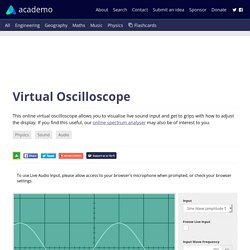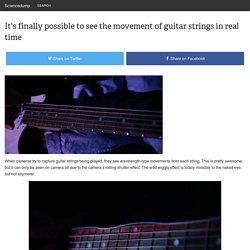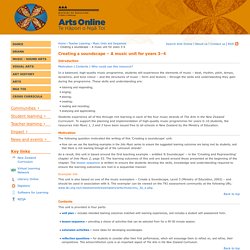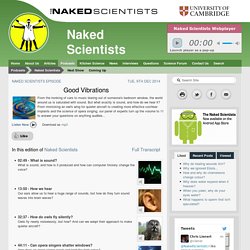

Vibration. See the unseen: Cymbal at 1,000 frames per second. Virtual Oscilloscope to show differences in sound waves in real time. An oscilloscope is a useful tool for anyone working with electrical signals because it provides a visual representation of the signal's shape, or waveform.

This allows you to measure properties of the wave, such as amplitude or frequency. The initial signal above is a 200Hz sine wave, which has an amplitude of 5 volts. The frequency of this wave can be adjusted by using the "Input Wave Frequency" slider. (You can also choose to display a square wave.)
If you are browsing using the latest version of Google Chrome, the input dropdown box allows you to select "live input". Since waveforms come in a wide variety of shapes, amplitudes and frequencies, oscilloscopes need to have a number of controls to adjust the display of the waveform so it can comfortably fit inside the viewport. Freeze live inputThis tickbox freezes the input allowing you to effectively take a snapshot of what is displayed on the oscilloscope at a given instant in time.
Fun Science: Sound. It's finally possible to see the movement of guitar strings in real time. When cameras try to capture guitar strings being played, they see wavelength-type movements from each string.

This is pretty awesome, but it can only be seen on camera all due to the camera’s rolling shutter effect. The wild wiggly effect is totally invisible to the naked eye, but not anymore! The Wobble Strings project is able to recreate a camera’s rolling shutter effect for the human eye in real time through a sweep line projection. To pull this off they let the speed of the sweep line control in accordance with the pitch of the strings.
Pretty clever right! To learn more about how they created this amazing Wobble String projector, be sure to watch the video below! Needing/Getting - OK Go Sandbox. Sensor Sounds: Magnet - OK Go Sandbox. Bouncy Balls - Bounce balls with your microphone! Sound Around You. Creating a soundscape – A music unit for years 3–4. Introduction Motivation | Contents | Who could use this resource?

In a balanced, high-quality music programme, students will experience the elements of music – beat, rhythm, pitch, tempo, dynamics, and tone colour – and the structures of music – form and texture – through the skills and understanding they gain during the programme. These skills and understanding are: listening and responding; singing; playing; creating; reading and recording; analysing and appreciating. Students experience all of this through rich learning in each of the four music strands of The Arts in the New Zealand Curriculum. Motivation The following question motivated the writing of this 'Creating a soundscape' unit: How can we use the teaching examples in the Into Music series to ensure the suggested learning outcomes are being met by students, and that there is rich learning through all of the curriculum strands?
Exemplar link Back to top Contents This unit is provided in four parts: Make a homemade hearing aid. Sssh.

Can you hear something? We can tell the difference between loud sounds and quiet sounds. You can even tell the difference between your mum's voice and your teacher's voice. How to Make Music with Water Glasses. Take your kids into the scientific aspects of music with this fun learning activity.

Not only will they learn how to make a water glass xylophone, but they will also see how making music with water glasses is a great way to integrate math and science lessons. You can find more music water glass activities on our blog. Copy the code in the box below to embed the instructographic on your site. <a href=" src=" alt="Music Water Glasses - Instructographic" title="Musical Water Glasses - Instructographic" width="600" height="2415" /></a><br/><br/><a href=" Academy - Online School for Grades K–12. Experiment with Musical Water Glasses > Virtual Learning Connections. Learning to read music can improve your math skills.

But can music help you learn science, too? Sure, it can! Here is a fun and scientific music activity you can do with your child at home. Just fill water glasses with different amounts of water to make music! Although this activity is simple, it’s a great way to exercise your student’s science skills and musical abilities. Star-Shaped Droplet Levitated By Sound. The Wikisinger. How to Make a Speaker. Naked Scientists Podcast Player. Acoustic Emission of a Bamboo Chopstick. CYMATICS - Science Vs. Music - Nigel Stanford. Good Vibrations. From the honking of cars to music blaring out of someone's bedroom window, the world around us is saturated with sound.

But what exactly is sound, and how do we hear it? From mimicking an owl's wing for quieter aircraft to creating more effective cochlear implants and the science of opera singing, our panel of experts turn up the volume to 11 to answer your questions on anything audible... Listen Now Download as mp3. Identify these sounds. WavesLesson4full. Music Lesson Incorporating Classroom Lessons. What Makes Your Ears Ring? Secret Sounds: a fun, at-home science experiment. Amazing Water & Sound Experiment #2. Harry Potter Theme - MUSICAL GLASSES - LIVE. Cornstarch Monsters - Cool Science Experiment. Sound,Bass,Water, Sound Devastates Water. Mario Theme song with bottles. Call Me Maybe - Music with bottle. Musical Bottles: a fun at-home science experiment. Making music with cups of water. Sounds of Science - Cool Science Experiment. Pyro Board: 2D Rubens' Tube! Sound - Sound, Interference, Pressure.
Schools Science Clips - Changing sounds. Amazing Resonance Experiment!